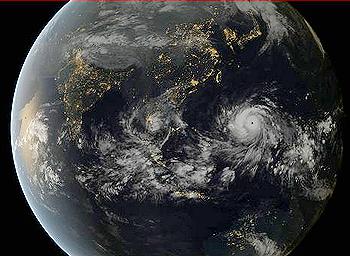
MANILA, Philippines, November 9, 2013 (ENS) – In the Philippines they call it Super Typhoon Yolanda, the rest of the world calls it Typhoon Haiyan, but everyone agrees this storm is one of the most powerful and dangerous typhoons ever to strike the storm-prone island nation.
Equivalent to a Category 5 hurricane on the U.S. Saffir-Simpson scale, the storm struck the central Philippines municipality of Guiuan at the southern tip of the province of Eastern Samar early Friday morning at 4:45 am local time. NASA calls it “one of the most powerful typhoons ever recorded.”

At least four people have been confirmed dead with many others reported injured and missing. Nearly 750,000 people were evacuated ahead of the storm, called the strongest of the year.
While interaction with the islands has caused the typhoon’s winds to decrease from its peak of 315 kph (195 mph), it remains a perilous typhoon as it blasts over the western Philippines.
At 4:00 am Saturday local time, the eye of Typhoon Yolanda was located 405 km (252 miles) west of San Jose, Occidental Mindoro, a province in the western Philippines.
Maximum sustained winds were clocked at 175 kph (109 mph) near the center of the typhoon with gusts of up to 210 kph (130 mph). The storm is forecast to move west northwest at 35 kph (21.7 mph), according to the Philippines Atmospheric, Geophysical and Astronomical Services Administration, PAGASA.
Super Typhoon Yolanda made several landfalls in various parts of the country Friday. A storm surge of roughly five meters (17 feet) was expected in the coastal city of Tacloban on Leyte; much of the local elevation is about three meters (10 feet) above sea level.
The typhoon crossed Masbate, Cebu, Panay, Romblon, Mindoro, and is expected to hit Palawan before exiting the Philippine area of responsibility late Saturday. The typhoon is headed for northern Vietnam, Cambodia and Laos and southern China, where the heaviest rainfall is expected.
The Philippine government is working to minimize the loss of lives, Presidential Communications Operations Office Secretary Herminio “Sonny” Coloma Jr. said Friday.
An additional P53.24 million (US$1.23 million) has been earmarked for assistance to those affected by Yolanda to be distributed through the Department of Social Welfare and Development, he said.
“What we in government have been doing is to be proactive. We are giving information to the public in advance so they can make informed choices and prevent loss of lives,” Coloma said at a media briefing Friday at Malacañang Palace, the office of President Benigno Aquino III.
“Our efforts to monitor Yolanda’s movements are meant to give people adequate warning,” Coloma said. “The government is going all-out to help protect people from the effects of Super Typhoon Yolanda.”
Department of Health Secretary Enrique Ona has ordered government hospitals to tend to those injured by the storm.
Government agencies are monitoring the water levels behind dams in areas where Yolanda has dumped torrential rains.
Meanwhile, the National Grid Corp. of the Philippines is working to restore electricity. There is no power flow from Luzon to the Visayas. The power is out across the entire provinces of Samar, Leyte, Bohol and Cebu. The islands of Negros and Panay have no power, the municipality of Mulanay in Quezon is dark and so are the municipalities of Bulan, Gubat and Irosin and Sorsogon.
“Aerial patrol, inspection and restoration of lines in the affected areas will be in full swing as soon as the weather allows,” the National Grid Corp says.
The Civil Aviation Authority of the Philippines had ordered the suspension of operations at airports in affected areas.
Coloma said the government aims to improve its disaster response mechanism. “We are not abandoning our goal of zero casualty,” he said. “That is still our target.”
Copyright Environment News Service (ENS) 2013. All rights reserved.
© 2013, Environment News Service. All rights reserved. Content may be quoted only with proper attribution and a direct link to the original article. Full reproduction is prohibited.
